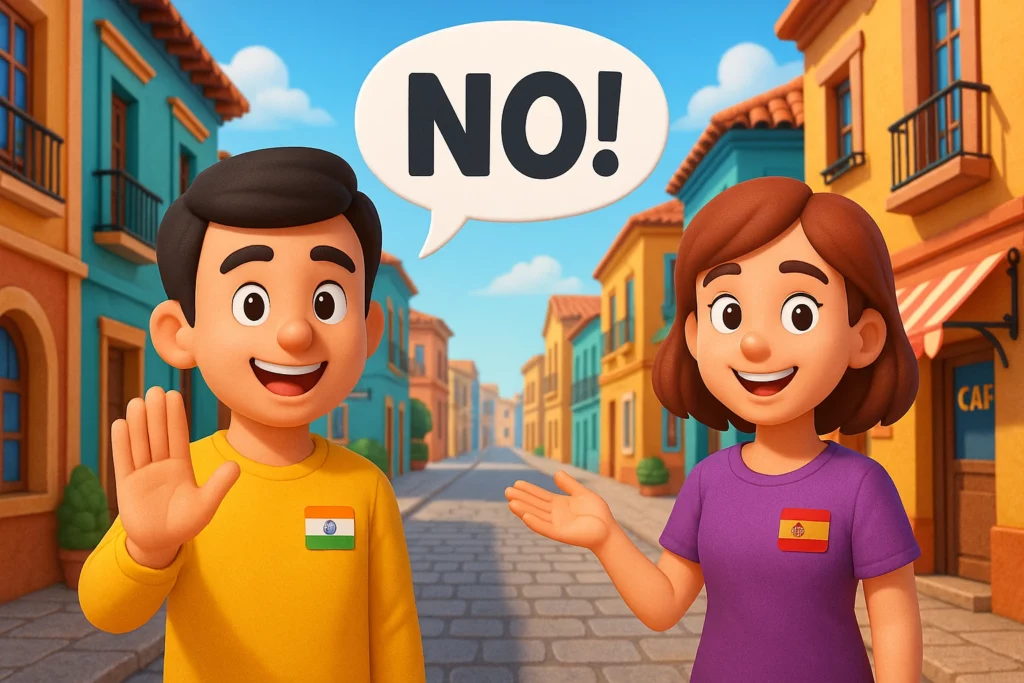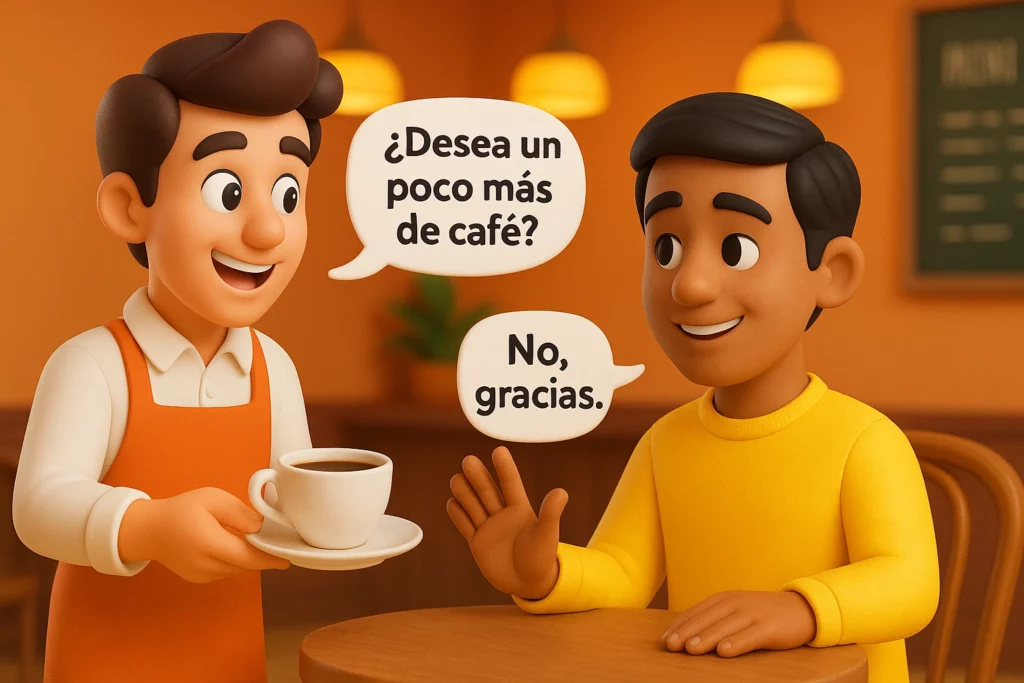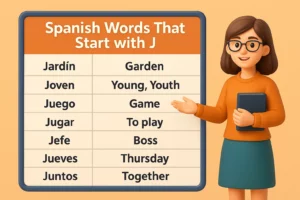
Have you ever been in a situation where “no” just doesn’t feel like enough?
Maybe you’re traveling through Spain, chatting with a Spanish-speaking friend, or working with clients from Latin America, and suddenly you need to say “no”—but you want to sound confident, polite, or even a bit playful, just like a local.
Knowing how to say “no” in Spanish is more than just using the word “no.”
It’s about understanding context, culture, and the right phrase for every situation—whether you need to say no to a dinner invitation, turn down an offer politely, or express a strong refusal. The good news? Spanish gives you a world of options, from warm and gentle to firm and funny.
In this guide, you’ll discover every possible way to say no in Spanish:
- The basics
- Polite refusals
- Strong denials
- Common slang
- Real-life example sentences and conversations
- And answers to every “no”-related question you might have (or Google might ask)
Ready to make your Spanish not just correct, but natural and impressive?
Let’s start mastering the art of saying no—in every way that matters.
What is “No” in Spanish? (The Simple Answer—and Why It Matters)
If you’re searching for the quickest answer, here it is:
The word for “no” in Spanish is simply “No.”
It’s pronounced almost the same as in English: noh.
But Spanish is a living language—sometimes just saying “no” isn’t enough. You might want to be polite, sound natural, or avoid any misunderstanding.
Let’s break down all the ways “no” appears in daily conversation, text, or travel situations.
Direct Translation: “No” in Spanish
No (noh) is the standard way to refuse, reject, or disagree in Spanish. Just like in English!
Examples:
- No. — No.
- No, gracias. — No, thank you.
- No hay problema. — No problem.
- No te preocupes. — No worries.
- No hablo inglés. — I don’t speak English.
- No más. — No more.
Where and When Do You Use “No” in Spanish?
- To answer a yes/no question:
— ¿Hablas español?
— No.
(Do you speak Spanish? No.) - To politely refuse:
— ¿Quieres café?
— No, gracias.
(Do you want coffee? No, thank you.) - To indicate absence or non-existence:
— No hay problema.
(There is no problem.) - To correct or disagree:
— No es bueno.
(It’s no good.)
Common Mistakes and Real-Life Tips
Never use “No” alone in a formal situation—add “gracias” or a reason to be more polite.
In texts and casual chats, you might see “nop” (informal, like “nope”).
“No” stays the same whether you’re talking to friends, family, or strangers—Spanish doesn’t change “no” for formality, but the tone and extra words matter!
Quick Reference Table
| English Phrase | Spanish Translation | Use/Tip |
| No | No | Direct refusal |
| No thank you | No, gracias | Polite refusal |
| No problem | No hay problema | Reassurance |
| No worries | No te preocupes | Comfort someone |
| No good | No es bueno / No está bien | Critique |
| No more | No más | Request to stop/limit |
| No speak English | No hablo inglés | For travelers |
| No one | Nadie | Expressing “nobody” |
| Yes and no | Sí y no | Mixed answers |
| Oh no | ¡Ay, no! / ¡Oh, no! | Express surprise/disappointment |
Mini-FAQ: What Is “No” in Spanish?
Q: What is ‘no’ in Spanish language?
A: “No.” It’s the same as in English.
Q: How do you say ‘no problem’ in Spanish?
A: “No hay problema.”
Q: How do you say ‘no thank you’ in Spanish?
A: “No, gracias.”
Polite Ways to Say No in Spanish (When You Want to Sound Friendly and Respectful)

In Spanish-speaking cultures, being polite matters—a lot!
Simply saying “no” can sound too blunt, especially to someone older, a colleague, or even a stranger.
Thankfully, the Spanish language gives you plenty of gentle, friendly, and respectful ways to say no without offending anyone.
Suggestion: 10 Classic French Novels for Language Learners.
1. No, gracias (No, thank you)
The most common and polite way to refuse something.
Example:
— ¿Quieres un poco más de café?
— No, gracias.
(Would you like a bit more coffee? No, thank you.)
2. No puedo (I can’t)
Use this to decline an invitation or request softly.
Example:
— ¿Puedes ayudarme mañana?
— Lo siento, no puedo.
(Can you help me tomorrow? Sorry, I can’t.)
3. No es posible (It’s not possible)
This phrase is polite, formal, and useful at work or in business.
Example:
— ¿Podemos entregar el proyecto hoy?
— No es posible, necesitamos más tiempo.
(Can we deliver the project today? It’s not possible, we need more time.)
4. No hay problema (No problem)
A nice phrase to reassure someone after saying no, or when someone apologizes.
Example:
— Disculpa por no poder ir.
— No hay problema.
(Sorry I can’t come. No problem.)
5. No te preocupes (No worries)
Say this if you want to comfort or reassure the other person.
Example:
— Me equivoqué, lo siento.
— No te preocupes.
(I made a mistake, I’m sorry. No worries.)
6. No, pero gracias (No, but thank you)
Sometimes, adding “pero gracias” (“but thank you”) makes your refusal sound extra friendly.
Example:
— ¿Quieres acompañarnos al cine?
— No, pero gracias por invitarme.
(Do you want to come with us to the movies? No, but thanks for inviting me.)
7. No, otra vez será (No, maybe next time)
If you want to keep things positive for the future.
Example:
— ¿Vas a la fiesta?
— No, otra vez será.
(Are you going to the party? No, maybe next time.)
Quick Tips for Sounding Polite in Spanish
- Smile and use a gentle tone. Politeness is not just about words—your attitude matters!
- Add “lo siento” (I’m sorry) before “no” for extra softness: Lo siento, no puedo (Sorry, I can’t).
- When in doubt, add “gracias” (thank you)!
Sample Conversation
- Carlos: ¿Te gustaría tomar algo?
- Marta: No, gracias. Ya he tomado mucho café hoy.
- Carlos: Bueno, otra vez será.
- Marta: ¡Gracias por preguntar!
If you can say “no” politely in Spanish, you’ll win hearts—and avoid awkward moments!
Strong, Firm, and Informal Ways to Say No in Spanish (When You Need to Be Clear!)

Sometimes, a polite “no” isn’t enough.
Maybe you want to sound firm, surprised, or just super casual—like friends do in real life!
Spanish is full of colorful ways to say “no,” and knowing them will help you sound confident and truly native.
Related: Mastering 30+ Essential Expressions with Avoir in French.
1. No way!
There are many cool ways to say “no way” in Spanish:
- ¡De ninguna manera! (No way!)
- ¡Ni hablar! (Not a chance!)
- ¡Qué va! (No way! Not at all!)
- ¡Ni de broma! (Not even joking!)
Example:
— ¿Vas a trabajar el domingo?
— ¡Ni hablar!
(Are you working Sunday? Not a chance!)
2. Oh no!
For moments of shock, disappointment, or surprise:
- ¡Oh, no! (Oh no!)
- ¡Ay, no! (Oh no! / Oh dear!)
Example:
— Se me cayó el helado.
— ¡Oh, no!
(I dropped my ice cream. Oh no!)
3. Not good / No good
To reject an idea, food, or situation:
- No es bueno. (It’s not good.)
- No está bien. (That’s not okay.)
Example:
— Este plan no es bueno.
(This plan is not good.)
4. No more
When you want something to stop or have had enough:
- No más. (No more.)
- Ya no. (Not anymore.)
Example:
— ¿Quieres más pastel?
— No más, gracias.
(Do you want more cake? No more, thank you.)
5. No one / Nobody
To say nobody or no one:
- Nadie (No one / Nobody)
- Ejemplo: Nadie vino a la reunión.
(No one came to the meeting.)
6. Yes and No
When you’re indecisive:
- Sí y no (Yes and no)
Example:
— ¿Te gustó la película?
— Sí y no.
(Did you like the movie? Yes and no.)
7. Informal, Slang, and Fun Ways
Native speakers use lots of casual phrases in daily talk:
- Nop (Nope)
- Nel (Nah; popular in Mexico)
- Nones (Nope)
- Nanay (No way; very informal, often for kids)
Example:
— ¿Me compras un helado?
— Nel, no hay dinero.
(Will you buy me ice cream? Nah, no money.)
8. Never / Not even in your dreams
When you want to be dramatic or funny:
- Jamás (Never)
- Nunca (Never)
- Ni en sueños (Not even in your dreams!)
Example:
— ¿Me dejas conducir tu coche?
— ¡Ni en sueños!
(Will you let me drive your car? Not even in your dreams!)
Quick Table: Strong, Firm & Fun Ways to Say No in Spanish

| English Phrase | Spanish Equivalent | Use-Case / Tone |
| No way | ¡De ninguna manera! | Strong refusal |
| Not a chance | ¡Ni hablar! | Firm, direct |
| No way (casual) | ¡Qué va! | Casual, dismissive |
| Not even joking | ¡Ni de broma! | Playful, informal |
| Oh no | ¡Oh, no! / ¡Ay, no! | Surprise/disappointment |
| Nope/Nah | Nop / Nel / Nones / Nanay | Very informal/slang |
| Not good | No es bueno / No está bien | Disapproving |
| No more | No más / Ya no | Stop/limit |
| Never | Jamás / Nunca | Absolute refusal |
| Not even in your dreams | Ni en sueños | Playful, dramatic |
Mini-Dialogue Using Strong & Fun Ways
Juan: ¿Vas a salir con ellos esta noche?
Sara: ¡Qué va! Estoy agotada.
Juan: ¿Ni un ratito?
Sara: ¡Ni en sueños!
Juan: Jajaja, bueno, será para otra vez.
(Are you going out with them tonight? — No way! I’m exhausted. Not even for a little while? Not even in your dreams! Haha, well, maybe next time.)
When you use these strong, casual, or slang “no” phrases, you sound much more authentic—and your Spanish friends will instantly know you “get it.”
Don’t Miss To Checkout: Mastering French ‘IR’ Verbs: A Guide To Conjugation And Usage.
Real-Life Dialogues & Scenarios: How to Say No in Spanish (Like It’s Second Nature)
Sometimes, memorizing phrases isn’t enough—you need to see them in action!
Let’s look at some real conversations where Spanish speakers say “no” in different ways. Practice reading them aloud, and soon you’ll sound like a pro.
1. Everyday Life: Refusing Politely
Luz: ¿Quieres un poco más de jugo?
Mateo: No, gracias. Ya estoy lleno.
Luz: ¿Seguro?
Mateo: Sí, de verdad. Pero gracias por ofrecerme.
(“Do you want some more juice?” “No, thank you. I’m full.” “Are you sure?” “Yes, really. But thanks for offering.”)
2. Saying No to a Friend’s Plan (Polite + Strong + Casual)
Raúl: ¿Te animas a ir al concierto esta noche?
Andrea: Lo siento, no puedo. Tengo mucho trabajo.
Raúl: ¡Oh, no! Yo quería que vinieras.
Andrea: Tal vez la próxima vez, ¿vale?
Raúl: Está bien, otra vez será.
(“Are you up for the concert tonight?” “Sorry, I can’t. I have a lot of work.” “Oh, no! I wanted you to come.” “Maybe next time, okay?” “Alright, another time then.”)
3. Family Chat: Saying No, But Staying Positive
Mamá: ¿Quieres más sopa?
Hijo: No más, gracias, mamá.
Mamá: ¿Nada?
Hijo: Nada, ya comí mucho.
(“Want more soup?” “No more, thanks, mom.” “Nothing?” “Nothing, I already ate a lot.”)
4. Friends Joking Around (Strong & Slang)
Pablo: ¿Me prestas tu bicicleta?
Luis: ¡Nel, ni en sueños!
Pablo: ¡Qué malo eres!
Luis: Jajaja, es broma.
(“Will you lend me your bike?” “Nah, not even in your dreams!” “You’re so mean!” “Haha, just kidding.”)
5. At Work: Polite & Formal “No”
Jefa: ¿Puedes terminar el informe hoy?
Empleado: No es posible, necesito más tiempo.
Jefa: ¿Seguro?
Empleado: Sí, lo siento, pero tengo otras tareas urgentes.
(“Can you finish the report today?” “It’s not possible, I need more time.” “Are you sure?” “Yes, sorry, but I have other urgent tasks.”)
6. “No Problem” & “No Worries” in Conversation
Cliente: Disculpe por llegar tarde.
Recepcionista: No hay problema, señor.
Cliente: Muchas gracias.
Recepcionista: No te preocupes.
(“Sorry for arriving late.” “No problem, sir.” “Thank you very much.” “No worries.”)
7. “Yes and No” — Giving a Mixed Answer
Sofía: ¿Te gustó la película?
Lucas: Sí y no. Me gustó el principio, pero el final fue aburrido.
(“Did you like the movie?” “Yes and no. I liked the beginning, but the end was boring.”)
8. “Long Time No See” and “No Speak English”
Amigo: ¡Cuánto tiempo sin verte!
Tú: ¡Sí, verdad! ¿Cómo has estado?
(“Long time no see!” “Yes, really! How have you been?”)
Turista: ¿Hablas inglés?
Local: No hablo inglés, lo siento.
(“Do you speak English?” “I don’t speak English, sorry.”)
Tip: Practice these conversations with a friend, or even by yourself in the mirror. The more you use these phrases, the more natural and confident you’ll sound in real Spanish situations!
Also Check: Comment écrire une lettre pour demander un prêt à son employeur.
Quick Reference Table: All the Ways to Say No in Spanish
| English Phrase | Spanish Translation | When to Use / Example |
| No | No | Direct, simple refusal – Do you like it? No. |
| No thank you | No, gracias | Polite refusal – More coffee? No, thank you. |
| No problem | No hay problema | To reassure/forgive – Sorry! No problem. |
| No worries | No te preocupes | To comfort – I’m late. No worries. |
| No good | No es bueno / No está bien | Critique – That plan is no good. |
| No more | No más / Ya no | Limit/stop – More cake? No more, please. |
| No one | Nadie | Talking about people – No one called today. |
| Yes and no | Sí y no | Mixed answers – Did you like it? Yes and no. |
| Oh no | ¡Oh, no! / ¡Ay, no! | Surprise, mistake – I lost my keys. Oh no! |
| No way | ¡De ninguna manera! ¡Ni hablar! ¡Qué va! | Strong refusal – Join us? No way! |
| Not a chance | ¡Ni hablar! | Very firm refusal – Work Sunday? Not a chance. |
| Nope / Nah | Nop / Nel / Nones / Nanay | Very informal – Another round? Nop. |
| Never | Jamás / Nunca | Absolute refusal – Eat that? Never! |
| Not even in your dreams | Ni en sueños | Dramatic, funny – Drive my car? Not even in your dreams! |
| No speak English | No hablo inglés | For travelers – Sorry, I don’t speak English. |
| No Spanish in English | No español en inglés | For fun/FAQ – Not a common phrase, just for clarity. |
| No rush | Sin prisa | To relax someone – Take your time, no rush. |
| Long time no see | Cuánto tiempo sin verte | Greeting old friends – Long time no see! |
Tip: Bookmark or print this table for quick revision before your next Spanish conversation, or even keep it on your phone while traveling!
FAQ’s – Saying No in Spanish
Q1: How do you say “no” in Spanish?
The simplest way is No.
It’s pronounced almost the same as in English: noh.
Q2: How do you say “no thank you” in Spanish?
Just say: No, gracias.
This is the most polite and common way to refuse something.
Q3: How do you say “no problem” in Spanish?
Use: No hay problema.
You can also say No te preocupes for “no worries.”
Q4: How do you say “no way” in Spanish?
There are several strong and natural ways:
- ¡De ninguna manera! (No way!)
- ¡Ni hablar! (Not a chance!)
- ¡Qué va! (No way! Not at all!
Q5: What is “no” in Spanish language?
It’s simply No—same as in English!
You can use it for refusal, disagreement, or correction.
Q6: How do you say “yes and no” in Spanish?
Say: Sí y no.
Perfect for mixed feelings or indecisive answers.
Q7: How do you say “no one” in Spanish?
Use: Nadie.
Example: “Nadie sabe la respuesta.” (No one knows the answer.)
Q8: How do you say “no more” in Spanish?
Use: No más or Ya no (not anymore).
Example: “¿Más agua? — No más, gracias.” (More water? No more, thank you.)
Q9: How do you say “no speak English” in Spanish?
Say: No hablo inglés.
This is a lifesaver for travelers!
Q10: How do you say “long time no see” in Spanish?
Use: Cuánto tiempo sin verte.
It literally means, “How long without seeing you.”
Q11: How do you say “no rush” in Spanish?
Say: Sin prisa.
For example: “Hazlo sin prisa.” (Do it, no rush.)
Q12: What’s the informal way to say “no” in Spanish?
You can say: Nop, Nel, Nones, or Nanay
These are fun, very informal ways used among friends and family.
Q13: How do you say “oh no” in Spanish?
Say: ¡Oh, no! or ¡Ay, no!
Q14: Is “no” in Spanish used the same way everywhere?
Mostly, yes! But informal words like “nel” or “qué va” are regional—Mexican Spanish, Spain, Argentina, etc. all have their own flavor.
Q15: How do you politely refuse in Spanish?
Add “gracias” (thank you), “lo siento” (I’m sorry), or “pero no puedo” (but I can’t) to sound friendlier.
Conclusion
Saying “no” might seem simple, but as you’ve seen, Spanish gives you a world of ways to do it—polite, firm, casual, even playful. Now you don’t have to worry about sounding rude or getting stuck in an awkward situation.
From “No, gracias” at a café to “¡Ni en sueños!” with friends, you have every phrase you’ll ever need. The more you practice these real-life examples and expressions, the more natural and confident your Spanish will sound.
So next time you need to say “no”—whether you’re traveling, chatting online, or making new friends—you’ll have the perfect Spanish answer for any situation.
Ready for a challenge?
Try using one new Spanish “no” phrase today, or tell us in the comments how you say “no” in your language!
Hasta la próxima, amigos. (See you next time, friends!)



